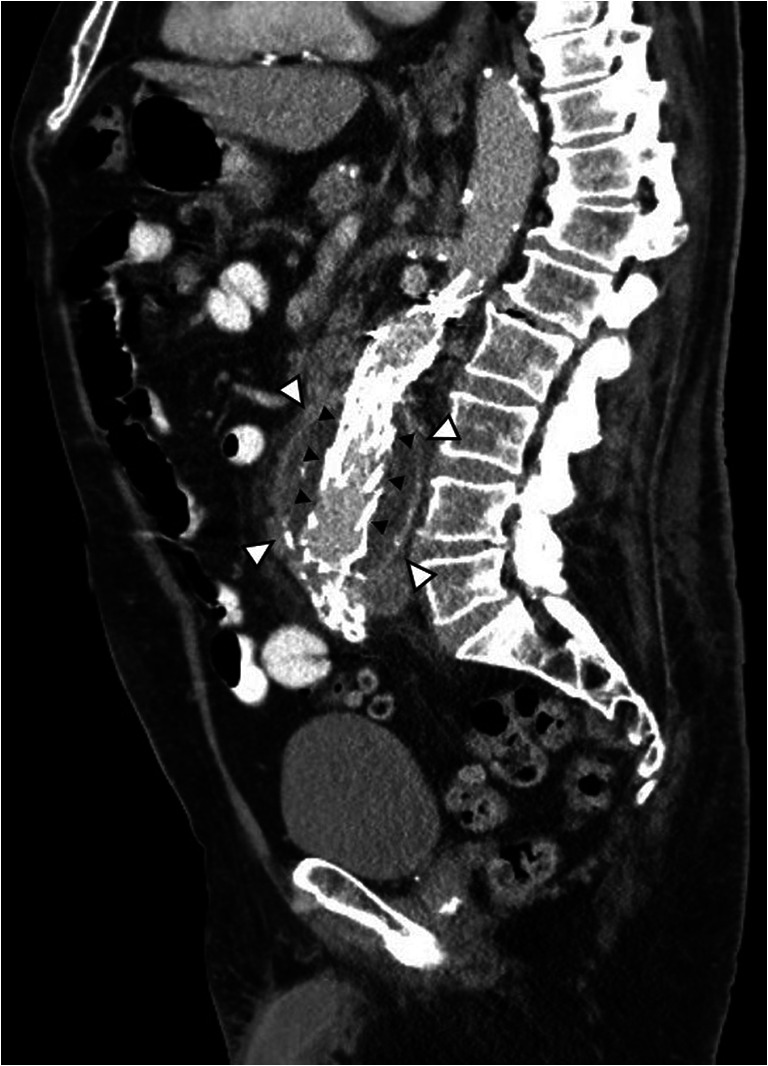CLINICAL DESCRIPTION
A 76-year-old man presented with fever, vomiting, hypoxia, and confusion. His medical history included an abdominal aortic aneurysm (AAA) status-post repair with an endograft 2 years prior. Blood cultures grew Bacteroides fragilis and an abdominal CT demonstrated AAA aneurysmal sac inflammation (Fig. 1). Indium-111 WBC scintigraphy showed AAA radiotracer localization (Fig. 2) consistent with a mycotic aneurysm. While undergoing surgical endograft explant with aortic reconstruction, this patient’s endograft was found in a “pool of pus.” He was later discharged for outpatient ertapenem infusions.
Figure 1.

CT demonstrating an inflamed aneurysmal sac (white arrows) surrounding the endograft (black arrows).
Figure 2.

Indium-111 WBC scintigraphy showing localization of tagged WBCs to the aneurysmal sac and endograft (black arrows). Areas of heavy aggregation of labeled leukocytes are visualized as bright yellow and orange in this image. White arrows surrounding the aneurysmal sac outline the area of probable infection. The lumbar vertebrae show white cell accumulation as a normal artifact which does not represent an inflammatory process.
Aortic graft infection is rare (incidence 0.3%),1 but is associated with high morbidity and mortality.2 Infection routes include bacteremic seeding and contiguous spread from a gastrointestinal source.3 In this patient, the hypothesized etiology was bacteremia from subclinical diverticulitis. Sepsis and enteric fistulae with gastrointestinal bleeding are worrisome complications.3 The most implicated organisms are Staphylococcus and Salmonella species.3 Bacteroides fragilis is a rare cause of mycotic aneurysm with only limited published case reports.4
Definitive treatment is complete surgical explant of the endograft and infected aorta followed by anatomical reconstruction1 and approximately 6 weeks of antibiotics.5 Antibiotic management alone is not recommended and is associated with high mortality.2 Even with treatment, 5-year mortality is estimated at 51%.2
Compliance with Ethical Standards
Conflict of Interest
The authors declare that they do not have a conflict of interest.
Footnotes
Publisher’s Note
Springer Nature remains neutral with regard to jurisdictional claims in published maps and institutional affiliations.
Contributor Information
Ian Coulter, Email: itcoulter@msn.com, Email: ian.coulter@ucdenver.edu.
Anunta Virapongse, Email: anunta.virapongse@ucdenver.edu.
References
- 1.Chaikof EL, Dalman RL, Eskandari MK, et al. The Society for Vascular Surgery practice guidelines on the care of patients with an abdominal aortic aneurysm. J Vasc Surg. 2018;67(1):2–77.e2. doi: 10.1016/j.jvs.2017.10.044. [DOI] [PubMed] [Google Scholar]
- 2.Smeds MR, Duncan AA, Harlander-Locke MP, et al. Treatment and outcomes of aortic endograft infection. J Vasc Surg. 2016;63(2):332–40. doi: 10.1016/j.jvs.2015.08.113. [DOI] [PubMed] [Google Scholar]
- 3.Wilson WR, Bower TC, Creager MA, et al. Vascular graft infections: mycotic aneurysms, and endovascular infections: A scientific statement from the American Heart Association. Circulation. 2016;134(20):e412–e460. doi: 10.1161/CIR.0000000000000457. [DOI] [PubMed] [Google Scholar]
- 4.Brook I. Anaerobic bacteria as a cause of mycotic aneurysm of the aorta: Microbiology and antimicrobial therapy. Curr Cardiol Rev. 2009;5(1):36–39. doi: 10.2174/157340309787048095. [DOI] [PMC free article] [PubMed] [Google Scholar]
- 5.Kim YW. Infected aneurysm: Current management. Ann Vasc Dis. 2010;3(1):7–15. doi: 10.3400/avd.cr09015. [DOI] [PMC free article] [PubMed] [Google Scholar]


